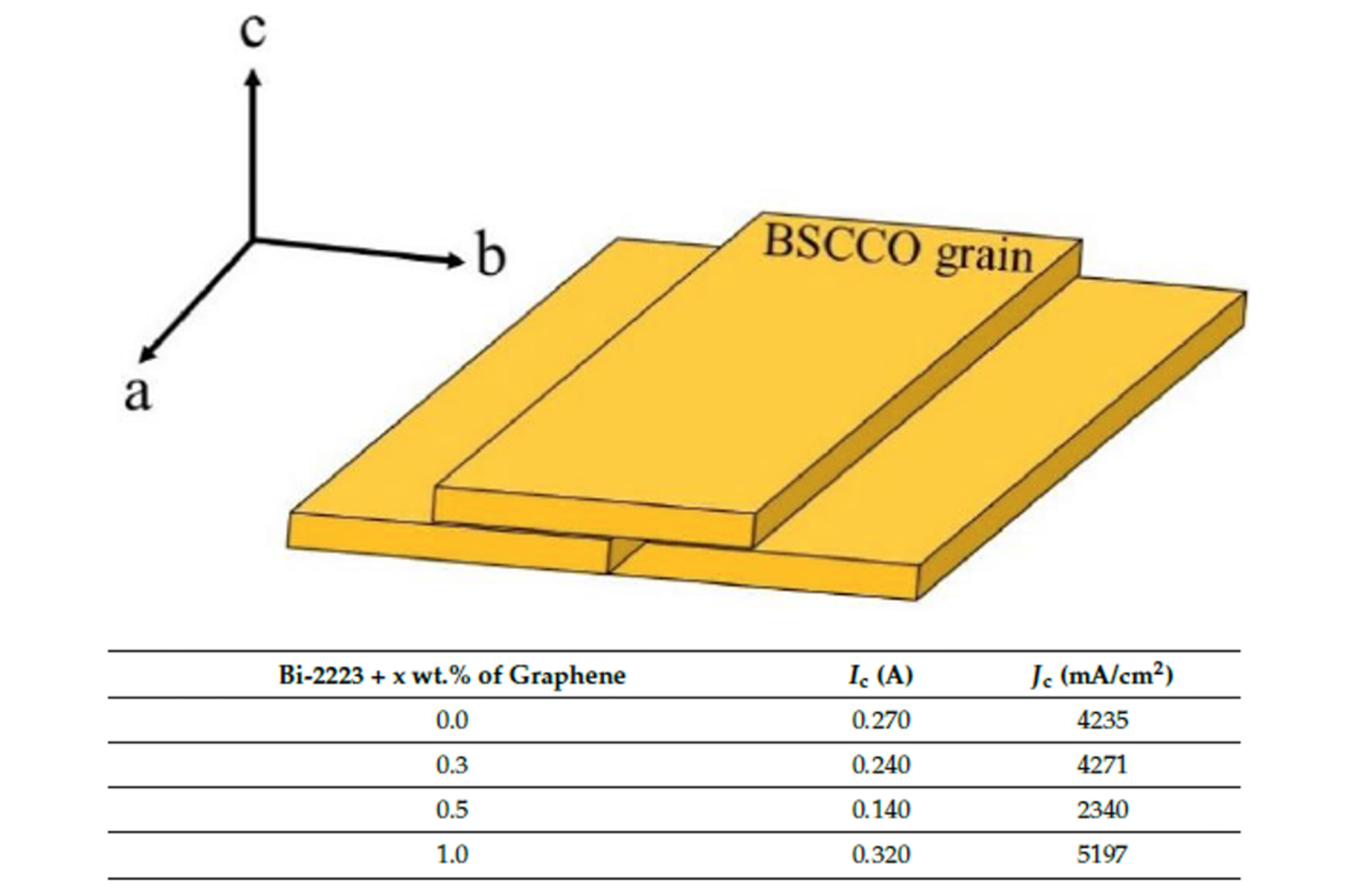High-temperature superconductors, exemplified by materials like Bi-2223, have long grappled with limitations such as low critical current density and inadequate magnetic flux pinning.

Variation of the critical current density of Bi-2223 (a bismuth strontium calcium copper oxide) with graphene addition. (Top) Schematic diagram demonstrating the parallel alignment of the BSCCO grain to its ab-plane. (Bottom) The table highlights that the Bi-2223 high-temperature superconductor sample with 1.0 weight percent graphene exhibits the highest critical current density (Jc). Image Credit: Muralidhar Miryala from SIT, Japan
Additionally, their intricate synthesis process has posed challenges to their advancement. In a recent study, an international team of researchers has demonstrated that by introducing graphene nanoparticles into bulk Bi-2223 using the co-precipitation method, it is possible to augment the critical current density. This breakthrough opens up new avenues for future research and development in the field of Bi-2223 superconductors.
Superconductors are substances that exhibit zero electrical resistance when cooled below a specific critical temperature. Generally, superconductors possess a very low critical temperature, often close to absolute zero. However, there exists a category of superconductors referred to as high-temperature superconductors (HTS) that have a critical temperature exceeding 77 K, which is the boiling point of liquid nitrogen.
HTS materials have found extensive applications in various industries for the creation of superconducting devices due to their ability to operate at relatively higher temperatures compared to conventional superconductors.
Bismuth strontium calcium copper oxide, commonly known as BSCCO, belongs to the class of HTS and has been extensively researched and utilized across various fields, including engineering, medical equipment, mining, and transportation systems. Within this class, (Bi1.6Pb0.4)Sr2Ca2Cu3O10, also known as Bi-2223, stands out for having the highest superconducting critical temperature, making it a subject of significant interest for potential applications.
However, the development and advancement of Bi-2223 superconductors have faced challenges. These include limitations such as low critical current density, subpar magnetic flux pinning capabilities, and a complex synthesis process. These hurdles have impeded the progress in harnessing the full potential of Bi-2223 superconductors.
In an effort to overcome these challenges, a team of researchers, under the leadership of Professor Muralidhar Miryala from the Materials for Energy and Environmental Laboratory of Superconducting Materials at Shibaura Institute of Technology, and Professor Awang Kechik Mohd Mustafa from the Department of Physics in the Faculty of Science at Universiti Putra Malaysia, conducted a study to explore the impact of adding graphene nanoparticles on the phase formation and superconducting characteristics of Bi-2223.
In this study, we report the effects on the critical temperature, critical current density, and structural and morphological properties of Bi-2223, when graphene nanoparticles are integrated into them using a novel co-precipitation method.
Muralidhar Miryala, Professor, Materials for Energy and Environmental Laboratory of Superconducting Materials, Shibaura Institute of Technology
This research was published in the Nanomaterials journal on July 28th, 2023. The study features a collaborative effort by a team of co-authors, including Abdullah Siti Nabilah, Nursyahirah Kamarudin Aliah, Soo Kien Chen, Kean Pah Lim, Abdul Karim Muhammad Khalis, and Shaari Abdul Halim from Universiti Putra Malaysia, Abidin Talib Zainal from Jeonbuk National University, Baqiah Hussein from Dezhou University, as well as Hashim Azhan and Ermiza Suhaimi Nurbaisyatul from Universiti Teknologi MARA Pahang.
Given the exceptional electrical, mechanical, and chemical attributes of graphene, along with the sheet-like microstructures common to both graphene and Bi-2223, the inclusion of graphene nanoparticles as additives presents an intriguing prospect. In their study, the research team scrutinized the phase formation and crystal structures of distinct Bi-2223 samples containing 0.3, 0.5, and 1.0 weight percent graphene nanoparticles. This analysis was conducted using X-Ray diffraction (XRD) and compared against a pure Bi-2223 sample. Additionally, they assessed the critical temperature of these samples using the alternate current susceptometry (ACS) method.
The X-Ray diffraction (XRD) findings unveiled the presence of a predominant Bi-2223 phase alongside a secondary Bi-2212 phase, which is another member of the BSCCO family, in all the samples examined. Notably, the volume fraction occupied by the Bi-2223 phase was higher in samples containing 0.3 and 0.5 weight percent graphene, but slightly lower in the sample with 1.0 weight percent graphene.
Furthermore, the ACS analysis showed that critical temperature-related parameters, including the onset critical temperature, phase lock-in temperature, and coupling peak temperature, all indicators of superconducting performance, decreased as the graphene content increased.
Surprisingly, the sample containing 1.0 weight percent graphene exhibited the highest critical current density and demonstrated the most suitable microstructure for the development of Bi-2223 superconductors.
These results suggest that the addition of graphene nanoparticles, acting as impurities, have the potential to enhance the current density of Bi-2223 superconductors.
Muralidhar Miryala, Professor, Materials for Energy and Environmental Laboratory of Superconducting Materials, Shibaura Institute of Technology
Describing potential future applications for Bi-2223 superconductors with improved current density, Prof. Miryala notes, “These superconductors have the potential to facilitate diverse fields, such as MRI imaging, power generation and distribution, renewable energy integration, transportation and aerospace, particle accelerators, electronics and quantum computing, environmental sustainability, industrial and manufacturing processes, and educational and scientific outreach.”
Journal Reference
Abdullah, S. N., et al. (2023). Microstructure and Superconducting Properties of Bi-2223 Synthesized via Co-Precipitation Method: Effects of Graphene Nanoparticle Addition. Nanomaterials. doi.org/10.3390/nano13152197.